5. Appendices
APPENDIX A: GLOSSARY
|
Term |
Abbreviation |
Description |
|
Anaerobic digestion |
Anaerobic digestion is a series of processes in which micro-organisms break down biodegradable waste material in the absence of oxygen. The process takes place within a digester - a warm, sealed, airless container. The process produces biogas, which can be used to generate heat and electricity, a fibre which can be used as a soil nutrient, and a liquid fertiliser. |
|
|
Amenity |
A positive element or elements that contribute to the overall character or enjoyment of an area or place. |
|
|
Biodegradable waste |
Waste that is capable of breaking down naturally, such as food and garden waste. |
|
| Biodiversity |
The variety of plants and animals and other living things |
|
| Biofuel |
Fuel produced directly or indirectly from biomass such as wood, charcoal, biodiesel and biogas (methane). |
|
|
Biomass |
Biological material derived from organisms, such as wood, waste and alcohol fuels. It is commonly plant matter grown to generate electricity or produce heat as a renewable energy source. |
|
|
BRE Environment Assessment Method |
BREEAM |
A tool designed to assess the environmental performance of new buildings |
| Bring sites |
Recycling schemes where the public deliver their waste recyclables to a central collection point, such as those in supermarket car parks for bottles and cans. |
|
| Brownfield land | Land that is or was occupied by a permanent structure (excluding agricultural or forestry buildings) and associated fixed-surface infrastructure (otherwise known as previously developed land) | |
|
Community strategy |
An overarching long term strategy designed to improve the quality of life and aspirations of an area. It sets out the overall vision and aims and priorities of the council and local partners (also known as the 'sustainable community strategy') | |
|
Combined heat and power |
CHP |
The process whereby fuels (both fossil and renewable) are used to produce electricity or mechanical power and thermal (heating and cooling). |
|
Composting |
The process whereby organic waste decomposes to form a compost or soil like mixture. As well as producing a useful material, it removes a significant and potentially polluting element of the waste stream and reduces demand for peat and other soil improvement products for horticulture and land reclamation. |
|
|
Core strategy |
A development plan document setting out the vision and objectives of the planning framework to guide development and the use of land within an area. It is one of the key elements of the LDF. Core strategies can cover specific topics, such as waste and minerals. |
|
|
Design and access statements |
Reports that accompany and support planning applications covering both the design principles and concepts applied to the proposed development. The level of detail will depend of the scale and complexity of the application. |
|
|
Development management |
DM |
The process whereby the local planning authority receives and considers the merits of a planning application and whether it should be given permission having regard to the development plan and all other material considerations. |
|
Development Plan Document |
DPD |
A document within the LDF which is used to make decisions on development proposals. DPDs are the equivalent of the adopted Unitary Development Plan (UDP) and are subject to public examination. DPDs must include a core strategy, site-specific allocations of land and a proposals map illustrating the spatial extent of policies within the LDF. Other types of DPD can include area action plans covering specific areas and detailed policies to assess planning applications. |
|
Dredging |
Waste material that is created to maintain waterways, such as rivers and canals. It is usually disposed via lagoons where excess water drains |
|
|
Employment land |
Land allocated for industrial and business use. |
|
|
Energy from waste |
The process of creating and recovering energy in the form of heat and power (e.g. electricity) from the burning of waste or through collecting gases, such as methane. |
|
|
Environment Agency |
EA |
A public body charged with protecting and improving the environment in England and Wales |
|
Environmental Impact Assessment |
EIA |
By law, some planning applications for large-scale development must include a detailed document which looks at the effects the proposal will have on wildlife, water quality, air quality and living conditions. |
|
Examination in public |
EIP | The process by which a government appointed and independent planning inspector assesses the soundness of the DPD (including any representations) and makes changes in a binding report following the examination |
|
Fly-tipping |
The unlawful dumping of waste on land |
|
|
Functional floodplain |
An area of land where water has to flow or be stored in times of flood. |
|
|
Gasification |
Unlike combustion, gasification involves a chemical reaction which takes place at high temperature. Carbon is converted to syngas, leaving a solid residue. This takes place in the presence of air or air enriched with oxygen. Energy can then be generated from gasification to produce electricity or steam. |
|
|
General core strategy |
Each council has prepared a general core strategy to provide the planning framework to guide all types of development (with the exception of waste) within their area. |
|
|
Geodiversity |
The variety of rocks, minerals and landforms and the processes that have formed these features over time. |
|
|
Greenhouse gases |
Gases which contribute to climate change. Naturally occurring examples include water vapour, carbon dioxide, methane, nitrous oxide and ozone. Some human activities increase greenhouse gases, including fossil fuel combustion within motor vehicles and some power stations. |
|
| Green jobs |
A job in an organisation that creates products and services that directly improve the quality of the environment i.e. reduce energy/ waste materials and protect water resources and ecosystems. Jobs are mainly found in waste management and energy conservation sectors. |
|
|
Green infrastructure |
A strategically planned network of integrated, multi-purpose and interconnected green spaces, linkages and other environmental features. |
|
| Household waste |
The proportion of municipal waste which is collected from domestic properties. |
|
|
Incineration |
Waste is burned at a very high temperature, and the heat released from this process is recovered and used to generate electricity and/or provide steam or hot water. An incinerator is a furnace for burning waste. Modern incinerators include equipment to reduce pollution, such as flue gas cleaning. Incinerators reduce the volume of the original waste by 95-96%, which greatly reduces the amount of waste going to landfill. |
|
| Inert waste |
Waste which is neither chemically or biologically reactive and will not decompose. Examples include sand, drywalls and concrete. |
|
|
In-vessel composting |
In-vessel composting is a means to dispose animal by-products arising from food processing and manufacturing plants, distribution premises, wholesale and retail outlets, food markets and catering facilities. There are strict regulations for their disposal. In-vessel composting is a proven treatment process, and a wide choice of compost technologies exist. |
|
|
Landfill site |
Sites where local authorities and industry can take waste to be buried and compacted with other wastes. The Environment Agency licenses and regulates landfill sites to ensure their impact upon the environment is minimised. | |
| Leachate | Liquids that drain or percolate through a landfill site. | |
|
Local Development Framework |
LDF |
A series of documents which provide the framework to shape the future of each area and guide and control development and the use of land |
|
Materials recycling facility |
MRF |
A facility for sorting, separating and packing or baling recyclable materials into individual materials prior to reprocessors, who wash and prepare the materials for manufacturing into new recycled products. MRFs can also be referred to as materials recovery or reclamation facilities. |
|
Mechanical biological treatment |
MBT |
A process which treats left over waste after recycling has taken place. Reusable and contaminated materials are separated from the waste stream via a mechanical process. The reminder is treated to create fuel products. |
|
Mechanical heat treatment |
Waste is treated using heat and/or steam which may or may not be applied under pressure. The treated waste is then removed for mechanical and/or manual separation. The process makes the waste dry and odourless, and it can be further processed as a fuel or sent to landfill. The process is similar to mechanical biological treatment, and is sometimes called autoclaving. |
|
|
Municipal waste |
Largely consists of waste collected from households (including bulky waste) and some businesses, and also includes waste from recycling centres as well as from street cleaning, litter bins and publicly owned parks and gardens. |
|
|
Municipal waste management strategy |
Councils have a legal duty to prepare these strategies to explain how municipal waste will be managed within their area. |
|
|
Private Finance Initiative |
PFI |
A method in which public and private sectors work in partnership to develop or operate new or improved waste management facilities. |
|
Planning condition |
A condition attached to a planning permission setting out requirements under which the development can take place (e.g. the use of specific methods of construction or hours of operation). |
|
|
Planning Policy Statement 10 |
PPS10 |
This sets out the government's national planning policies on waste management. |
|
Planning Policy Statements |
PPS |
National statements of government policy relating to planning |
|
Proposals map |
An ordnance survey map illustrating the policies and proposals within the LDF covering specific sites, land uses and areas. |
|
|
Pyrolysis |
A process where waste is heated and broken down in the absence of oxygen. The process can be used to create fuel and renewable energy sources. | |
| Resource recovery parks |
A group of businesses working together to recover, reuse and recycle waste in one location. |
|
|
Safeguarded site |
An existing waste management or disposal site that will be protected from development or activity, either on the site itself or in the vicinity of the site, which may prejudice its ability to fulfil the function for which it has been identified | |
|
Segregation |
A process through which waste is separated into different categories to reduce the costs of waste disposal and encourage recycling and reuse. Local businesses may be able to use the waste as a raw material. |
|
|
Site waste management plans |
These set out how waste resources will be managed during all stages of the development. It is a legal requirement in England for all construction projects over £300,000. The level of detail that site waste management plans must contain will depend on the size and cost of the construction project. |
|
|
Strategic Environmental Assessment |
SEA |
Part of the sustainability appraisal specifically assessing the effects of the plan on the environment as required under the EU Directive 2001/42/EC |
|
Supplementary Planning Document |
SPD |
A non-statutory document which forms part of the Local Development Framework and provides further detail and guidance on the policies and proposals contained in a development plan document. SPDs have no legal status and are not subject to public examination. |
|
Sustainability appraisal |
SA |
A legal assessment of the economic, environmental and social effects of a plan from the outset of the preparation process to make sure decisions are made in line with the principles of sustainable development. |
| Sustainable waste management |
The concept, enshrined in legislation, essentially means using resources as efficiently as possible to cut down on waste and green house gas emissions. In practice, it means developing high quality and environmentally efficient collection, recycling and treatment services close to where waste is generated. |
|
|
Unitary authority |
An administrative unit of Great Britain. Unitary authorities are responsible for all local government services. |
|
|
Use classes order |
Specifies groups of uses within which a change of use does not constitute development and is therefore do not require a specific planning permission. |
|
|
Waste collection authority |
A section of the council that collects household waste. Councils also have a duty to collect commercial waste if requested to do so and may also collect industrial waste. The waste collection authority may differ from the waste disposal authority. |
|
|
Waste disposal authority |
A section of the council that manages and disposes the waste it collects from homes and businesses |
|
|
Waste hierarchy |
The waste hierarchy provides a framework within which waste management decisions can be made in line with government objectives. The most effective environmental option is to prevent or reduce waste in the first place. Where this is not possible, products and materials should be re-used either for the same or different purpose. Failing that, value should be recovered from waste through recycling, recovery and composting. However, landfill sites should only accept waste as a last resort where there are no alternative options available. |
|
|
Waste minimisation |
Minimising waste sits at the top of the waste hierarchy and involves prevention, reuse and recycling - it is essentially about reducing the environmental impact of waste. Benefits include:
|
|
|
Waste transfer station |
A site to which waste is delivered for sorting or baling prior to transfer to another place for recycling, treatment or disposal. |
|
|
Windrow composting |
The aerobic (i.e. involving oxygen) decomposition of shredded and mixed organic waste using open linear heaps known as 'windrows', which are approximately three metres high and four to six metres across. |
APPENDIX B: LOCATION PLANS OF THE SAFEGUARDED STRATEGIC SITES (POLICY WCS2)
Safeguarded Site Plan - Grange Lane
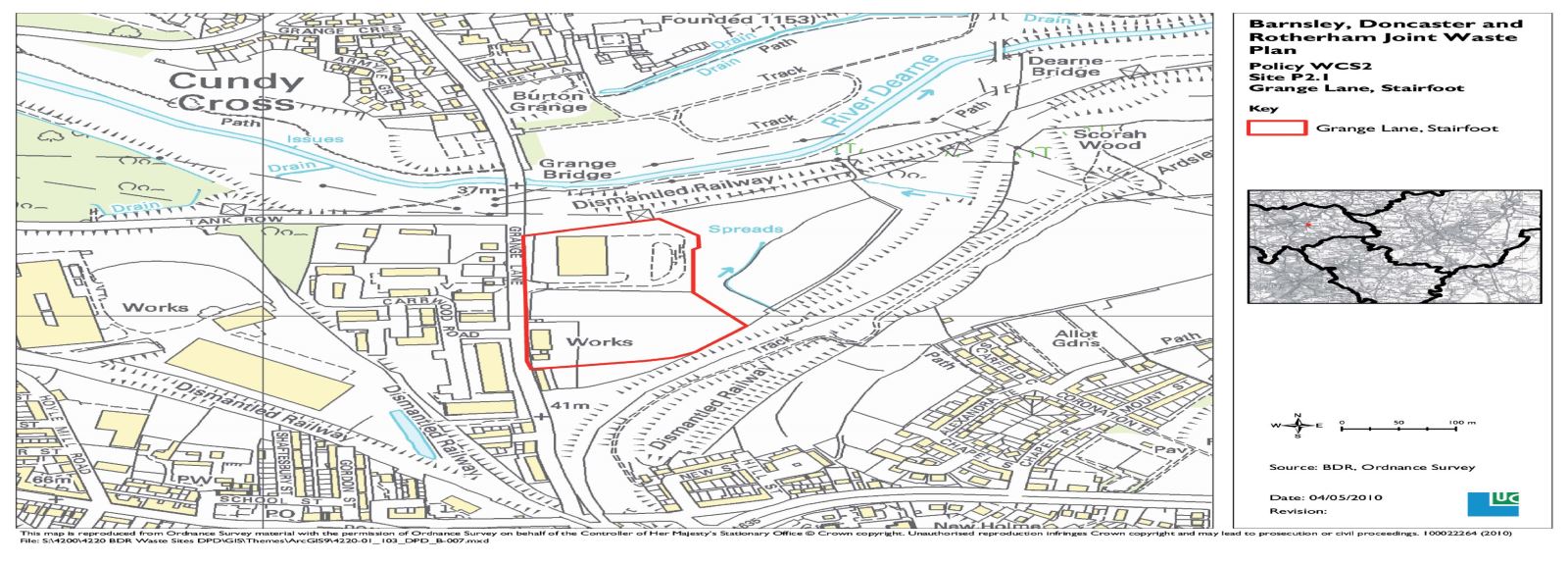
Safeguarded Site Plan - Wroot Road Quarry

Safeguarded Site Plan - Brier Hills Farm
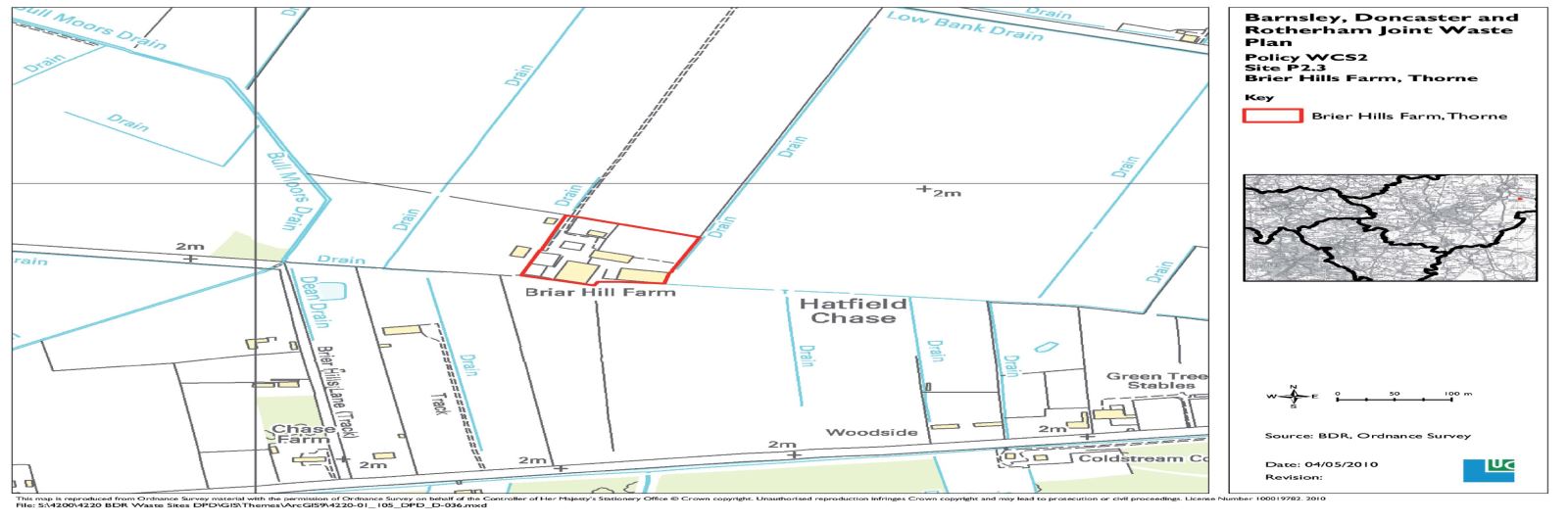
Safeguarded Site Plan - Sterecycle

Safeguarded Site Plan - Long Sandall
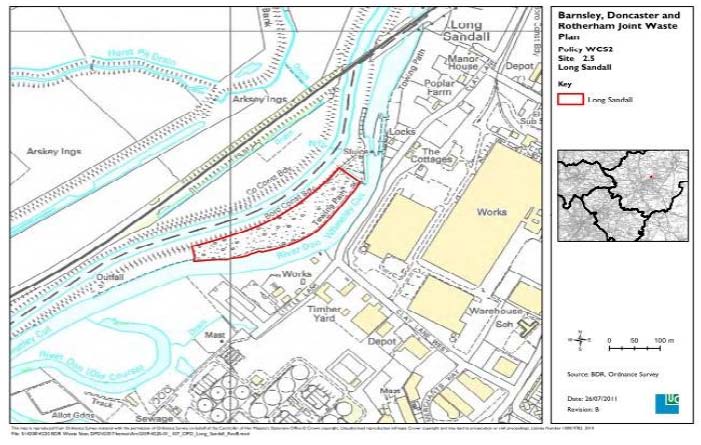
Safeguarded Site Plan - Eastwood
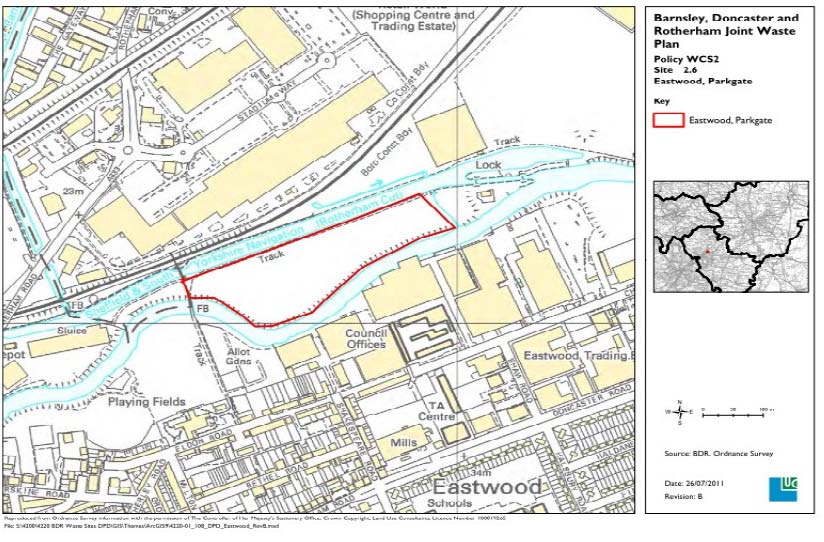
Safeguarded Site Plan - Rotherham Road

APPENDIX C: LOCATION PLANS OF THE NEW STRATEGIC SITES AND RESERVE SITE (POLICY WCS3)
Site Plan - Sandall Stones Road

Site Plan - Hatfield Power Park

Site Plan - Bolton Road, Manvers
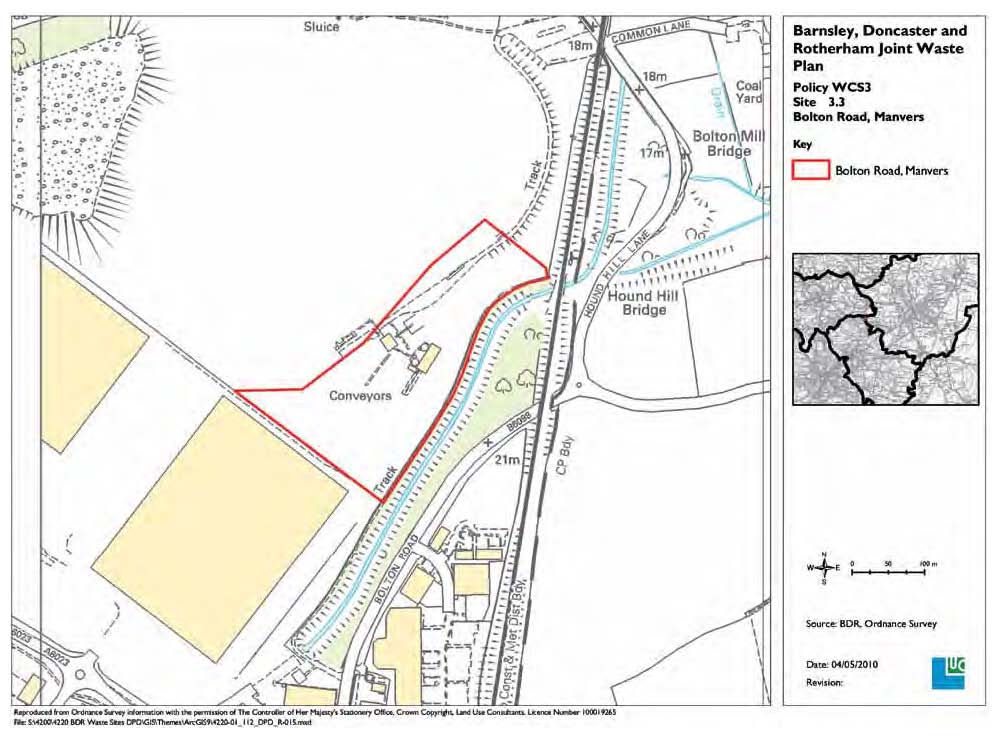
Site Plan - Aldwareke Steelworks

APPENDIX D: UNITARY DEVELOPMENT PLAN POLICIES TO BE REPLACED
The policies contained in the Joint Waste Plan will replace a number of policies which are contained in each borough's Unitary Development Plan. The following table shows how policies have been replaced.
Barnsley
|
Joint Waste Plan policy |
Relevant UDP policy |
|
Policy WCS1 |
Policy WD1: Need for waste disposal sites |
|
Policy WCS1 |
Policy WD2: Recycling |
| Policies WCS3 and 6 |
Policy WD3: Environment |
| Policies WCS3 and 6 |
Policy WD3A: Environment |
| Policies WCS3 and 6 |
Policy WD3B Environment |
| Policies WCS3 and 6 |
Policy WD3C Environment |
|
Policies WCS4 and WCS5 |
Policy WD3D Environment |
| Policies WCS3 and 6 |
Policy WD4: Transportation |
|
Policy WCS6 |
Policy WD5: Improved standards |
| Policies WCS4 and WCS5 |
Policy WD5A: Improved standards |
|
Policies WCS5 and WCS6 |
Policy WD5B: Improved standards |
|
Policies WCS5 and WCS6 |
Policy WD5C: Improved standards |
|
Policies WCS3 and 6 |
Policy WD6: Pollution gas |
| Policies WCS3 and 6 |
Policy WD7: Pollution gas |
|
Joint Waste Plan policy |
Relevant UDP policy |
|
Policy WCS1 |
Policy SWD1: Waste management strategy |
|
Policies WCS1 and 6 |
Policy WD2: Support landfill gas |
|
Policies WCS1 and 6 |
Policy SWD3: Solvent recovery and special waste |
|
Policies WCS1 and 6 |
Policy WD4: Preference for derelict sites and mineral sites |
|
Policy WCS6 |
Policy WD5: Protection of water resources and flood defences |
|
Policy WCS6 |
Policy WD6: Protects agricultural land |
|
Policy WCS5 |
Policy WD7: Improve agricultural land by landfilling |
| Policy WCS6 |
Policy WD9: Public rights of way |
|
Policy WCS6 |
Policy WD11: Sites of regional/local importance |
| Policies WCS3, 4 and 6 |
Policy SWD6: Working and reclamation |
|
Policy WCS6 |
Policy WD12: Landscaping |
|
Policies WCS4 and 5 |
Policy WD13: Working, restoration, aftercare |
|
Policies WCS4 and 5 |
Policy WD14: Working, restoration, aftercare |
| Policies WCS4 and 7 |
Policy WD15: Landfill detail |
|
Policy WCS5 |
Policy WD16: Aftercare |
|
Policy WCS6 |
Policy SWD7: Development near landfills |
|
N/A |
Policy SWD9: Colliery spoil |
Rotherham
|
Joint Waste Plan policy |
Relevant UDP policy |
|
Policies WCS4 and WCS5 |
Policy WM 1.1: Land reclamation schemes |
|
Policies WCS5 and 6 |
Policy WM 1.2: Assessment of waste management proposals |
|
Policy WCS3 |
Policy WM 1.4: Agricultural tipping |
|
Policies WCS4 and WCS5 |
Policy WM 1.9: Landfill gas |